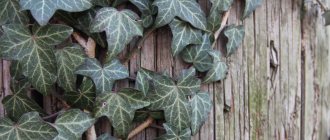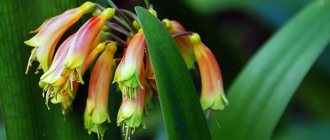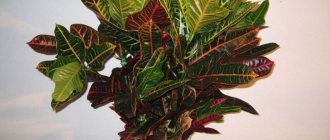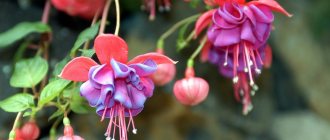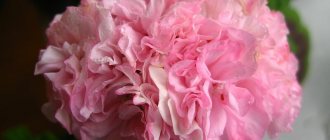Adromiscus is a plant that belongs to the Crassulaceae family. It is a succulent that is just gaining popularity. The reason is that this grass complements the interior well. Looks great both in a cozy apartment and in the office.
Author of the article
Maxim Sverchkov
Professional biologist and breeder with extensive experience and experience.
Features of the plant
The leaves are unusually juicy and fleshy, decorated with decorative spots. With a lack of sunlight, a succulent may lose such a specific ornament, turning into a monochromatic one.
The peduncle is thrown high up to 40 cm, and on it is an inflorescence-spike. Making a bush bloom is difficult even in a greenhouse, and even more so in indoor conditions. But the representative of the Crassulaceae family is more valued not for its small, inconspicuous flowers, but for the unusual shape of its leaves.
Watering
When it comes to watering Adromiscus, there is no need to worry too much about it. Thanks to their succulent leaves, the plants can store large amounts of water and do not require frequent watering. Make sure you check the soil between waterings to avoid over-watering. If it feels dry to the touch, water immediately.
Remember that it is always better to submerge succulents rather than flooding them with too much water.
However, if your succulent doesn't get enough water, the foliage will darken and die over time. Otherwise, an overwatered succulent will show its pain through yellow and soft leaves that can no longer be saved.
Plants will benefit most from watering during the active growing season from spring to fall. In winter, succulents need to be watered once every two to three weeks, when the soil is completely dry.
Home care
Adromiscus is accustomed to life in the desert, so its conditions should be kept as close to arid as possible. A lot of light, warmth, low air humidity, infrequent watering and protection from drafts in winter will help this succulent feel at home in your apartment and reward you with its decorative value for your care.
Advanced flower growers boldly experiment, planting several micro bushes in one pot for greater beauty. If you decide to repeat their experiment, do not plant different types of Crassulaceae in the same pot. It is better to alternate one type of Adromiscus with aizoonaceae.
Location and lighting
The desert dweller Adromiscus is not afraid of the sun, so you can safely place it in a south window. South-east and south-west placements are also suitable. There is no need to shade, but be sure to provide ventilation, otherwise the fleshy leaves may get burned. If the balcony faces the sunny side, be sure to place the succulent there for the summer.
Temperature
In the warm season, it is advisable to provide the plant with a temperature within +25-27°C. If the thermometer rises to 30 degrees, be sure to create a slight draft so that the leaves do not burn.
In winter it can withstand +8-12°C. If the temperature drops to 7 degrees or lower, Adromiscus may die.
Watering
Like any succulent, the bush is not particularly spoiled by moisture. Therefore, water it sparingly. Until the soil dries, do not add life-giving moisture. Even if the soil outside is dry, wait another 4-6 days before watering.
In winter you need to do this even less often. If the room is cool, you can stop watering altogether for a while.
Do not use cold water, take only soft water and always at room temperature. Before watering, the water must settle.
Air humidity
There is no special need to increase the air humidity in the room, since Adromiscus prefers dry air. Since the leaves are able to accumulate moisture, there is no need to spray the plant either.
The soil
Soil for Adromiscus can be purchased at the store. Choose soil for cacti or succulents. You can play it safe by adding charcoal or river sand to the mixture to improve the health of the roots. Be sure to line the bottom of the pot with a thick layer of drainage.
If you want to prepare the soil mixture yourself, mix the following ingredients:
- coarse sand (30%);
- garden soil (20%);
- humus (20%);
- charcoal (10%);
- bone meal (10%);
- lime (10%);
- some eggshells.
Heat all the ingredients in the oven, let cool and mix well.
Feeding and fertilizers
In winter, leave the bush alone. And, starting from March and until the end of summer, add fertilizer once a month. Choose for cacti and succulents.
Transfer
Adromiscus does not need to be replanted very often. Do this approximately once every two years. When you notice that it feels cramped in the old pot and the roots are protruding from the drainage holes, replant it. It is advisable to begin action in the spring.
Take a wide, low pot. Line the bottom with drainage. The layer of pebbles should be at least 5 cm. Sprinkle the soil mixture on top, adding brick chips or coals.
Do not water the plant for a couple of days. Using a knife, carefully scrape the soil away from the edges of the pot. Pull out the bush and, together with the earthen lump, transfer it to a new place, without burying the stem too deeply. Do not overwater the plant to prevent the roots from rotting.
Immediately transplant the purchased representative of the Tolstyankov family into a new bowl. Keep it in a cool, unlit place for several days without watering. And after transplanting, move it to a sunny windowsill and resume watering.
Trimming
After flowering has finished, give the succulent a little rest. Only after 2-3 weeks, cut off the dried stems on which there were buds. This should be done with a sharp knife, previously wiped with alcohol.
Temperature
Adromiscus thrive in warm environments (ideal temperature 24°C), but they resist well even in colder temperatures. Adromischus tolerates cool temperatures well in the absence of frost in winter if kept dry. Their limit is 5-10 °C. In winter, it is good to place plants in a sheltered place, especially away from rain: stagnation of water between the foliage can be fatal.
Reproduction
There will never be any problems with the propagation of this plant. You can propagate by cuttings, individual leaves, dividing the bush and leaves. If you do this in the spring and not in the summer, you will be able to preserve all varietal characteristics.
Propagation by sheets
Cut off the thickest leaves from the bush. Place in a cool, dark place for 3-4 hours. Then plant it in the ground for cacti. Deepen the leaves by 2 cm. Cover the pot with film and place in a warm place, hidden from sunlight.
Don’t forget to moisten the soil every day and remove the plastic to ventilate. Remove the cover immediately after new leaves appear. In about a month, rooting will occur.
Propagation by seeds
Only seasoned flower lovers can use this method with a successful outcome. The process is complex and lengthy, so if you are not sure, it is better not to take risks. Pour the soil into the prepared container and level it. Scatter the seeds evenly, sprinkle with sand and cover with glass on top. Keep at a temperature not lower than 20 degrees.
Shoots should appear in approximately two weeks. After the sprouts grow, plant them in separate pots. Bushes grown in this way will bloom in 2-3 years.
Dividing the bush
In this matter, it is important to maintain sterility, so before starting work, disinfect the instruments, otherwise bacteria will immediately attack the cut sites, which can kill your patient.
Cut a piece of the root with a sharp knife, let it dry, sprinkled with charcoal. Plant in prepared moist soil, sprinkled with soil. Install close to the window. Water only with slightly warmed, settled water.
Propagation by cuttings
After cutting out a leaf rosette, keep it in a dark place, and then plant it in a container with vermiculite. After the roots appear, transplant into separate 7-centimeter pots.
How to propagate succulents of the genus Adromischus
To obtain such a spectacular bush, the leaf method is used, as well as dividing the bush. Adromiscus seeds are not used for these purposes. Let's take a closer look at both methods
Propagation of Adromiscus by leaf
Cut a leaf from the plant and place it in a dark room. After 7-9 days, small roots will form on it.
Adromiscus leaf with emerging roots
Now it is enough to sprinkle the surface a little with soil. After some time, babies will begin to appear, usually 3-4 of them. If desired, they are divided to grow separate crops. While the baby is sprouting, be sure to water the soil. It will take 1 year to obtain full-fledged bushes.
Plant propagation by dividing the bush
This option is relevant during the growing season. The roots are cut with a sharp knife, then dried and treated with charcoal. If all processes are carried out correctly, the desired result will be achieved.
Diseases and pests
Adromiscus can be annoyed by aphids, mealyworms, and spider mites. This happens rarely, but when you notice pests, first wipe the leaves with a piece of cloth soaked in ethyl alcohol. After this, treat with garlic or wormwood infusion. You can also use store-bought insecticides.
Care errors
If you make mistakes in caring for Adromiscus, the plant will immediately give signals. The main thing is to decipher them correctly and take urgent measures to eliminate the shortcomings.
The dying and yellowing of the lower leaves should not scare you. This is evidence of old age. But the appearance of rot indicates moisture getting into the outlet.
If the top leaves turn yellow and dry out, it means that you either overwatered the plant or suffered a sunburn. Overwatering can still rot the roots. If such a situation arises, cut the cuttings and plant them, but the old bush will have to be destroyed - it will not be possible to save it.
Leaves crack due to too infrequent watering. If the shoots are stretched out and the leaves are faded, it means that the plant does not have enough light.
Problems when growing Adromiscus
This is a strong plant that is resistant to various pests and diseases of Adromiscus. However, in some cases, you can see, for example, spider mites on the leaves. You can first walk over the leaves with a damp cloth. However, the best control method is the use of insecticides.
If the leaves are cracked, this means that you need to reduce the dose of watering. If you don't do this soon, the roots will begin to rot.
Another article described: Agave
Adromiscus species
In total, there are about fifty species of Adromiscus in the wild, but only a few of them are cultivated indoors. Let's look at the distinctive features of the most popular ones.
Adromis chuscristatus
The young plant has erect stems. But over time they begin to sag and fall apart. As it grows, aerial roots grow. The leaves, collected in rosettes, are dark, convex, wavy with a slight edge. To make them dense and reach a centimeter thickness, you will have to try hard. The buds bloom greenish-white with pink edges.
Cooper's Adromiscus (Adromischus cooperi)
The shoots spread below, and oval glossy green leaves with wavy edges, decorated with brown streaks, are attached to them. Red-green tubular flowers in the form of a spike are framed along the edges with white, purple or scarlet color. The most unpretentious species from the Crassulaceae family.
Poellnitz's Adromiscus (Adromischus poellnitzianus)
A tiny 10-centimeter bush with branched dark green shoots, generously decorated with brown hair. The stems are convex at the bottom, and become flat closer to the top. Whitish hairs can be seen on the surface. Pellnitsa throws out a high 40-centimeter arrow with small, not very beautiful flowers at its top.
Spotted Adromiscus (Adromischus maculatus)
A weakly branching specimen with large rounded leaves decorated with brown-red spots on both sides. The low bush blooms creamy-purple. The buds are not too pretty. This species is valued for its decorative leaves.
Adromischus trigynus
The low succulent is distinguished by thick, rather long shoots. Branches well. Brown spots are scattered across the dark rounded leaves. The flowers are unattractive red-brown in color.
Adromiscus marianaeherrei
The red leaves have an unusual texture reminiscent of volcanic lava. A very light-loving bush. In shade or partial shade it can lose its bright color, changing the color of the leaves to normal green. In addition, without the sun it will stretch unattractively upward. It grows very slowly. It has several subspecies, differing in leaf shape.
Feel free to start growing this ornamental plant, even if you are new to floriculture. Create conditions for Adromiscus that are as close to desert conditions as possible, and then you will not have problems growing this wonderful succulent.
Description of the genus of succulents Adromiscus
The genus name Adromischus means “thick stem” and belongs to the family Crassulaceae (Crassulaceae). The culture is most widespread in the south of the African continent. The plant is usually herbaceous, subshrub type, which has a creeping stem. The bush can reach a height of up to 0.15 meters.
Photo of one of the Adromiscus species
The stem is found in a contrasting shade of terracotta; it can be covered with roots, so it often visually resembles palm trees in miniature. The root system is used to consume moisture and nutritional components from the air. It is very thin, thread-like, and needs special attention.
The leaves are quite thick, fleshy, and can be colored green or variegated. Their shape is predominantly round or triangular; the leaves are fixed on a short but fairly dense petiole. The width of the leaves is up to 0.5 meters, and the thickness is 1 centimeter.
The flowering will delight you with white and pink colors, the shape of the buds is tubular. The spicate shape of the peduncle attracts attention and has a spectacular appearance.
Growing conditions
Illumination
To preserve valuable leaf spotting, bright lighting is necessary. Place a flower pot with adromiscus on a southern windowsill, but in summer afternoons it is advisable to shade it with a sheet of paper or half-closed blinds. Grows well on windows facing east or west. On the north side there is a lack of light, especially in winter.
Air temperature
In spring and summer it needs warmth and grows normally in the temperature range of 25-30 °C. At higher rates, ventilate the room more often, if possible, move it to fresh air (veranda, balcony, garden). Wintering is preferably cool so that Adromiscus accumulates strength. Maintain the temperature between 10-15 °C, but the mark should not fall below 7 °C.



